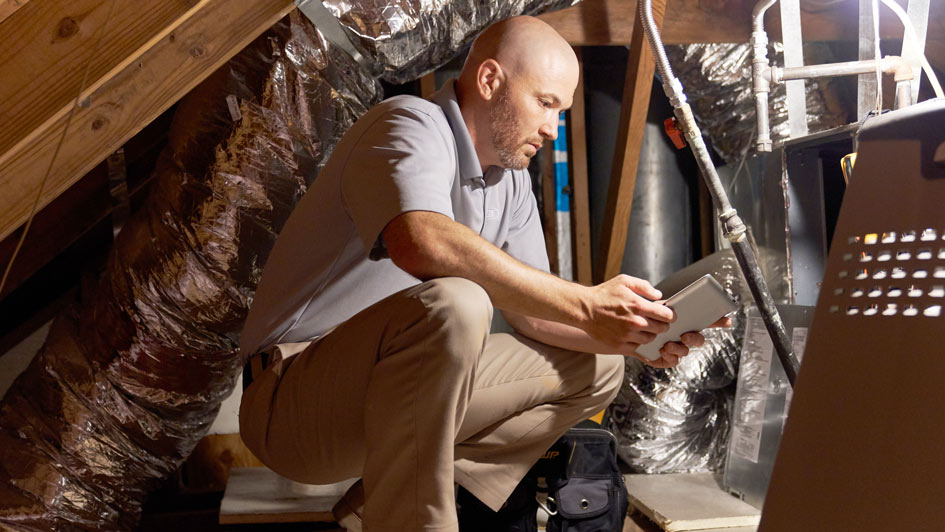
Did you know that more than 50% of your home’s energy costs are needed for your heating and cooling? That’s why it’s so important to secure an energy-efficient HVAC system.
Furnace efficiency standards were last revised to an Annual Fuel Utilization Efficiency (AFUE) rating of 80% in 2015. This rating system illustrates how effective your furnace is at natural gas into heat. An AFUE rating of 80% means your furnace loses about 20% of the fuel it uses while producing heat.
In 2022, the Biden Administration revealed new energy-efficiency standards for residential gas furnaces that would significantly reduce emissions, save consumers money and encourage sustainability.
This proposal is expected to:
- Save Americans $1.9 billion annually.
- Cut carbon emissions by 373 million metric tons and methane emissions by 5.1 million tons over the next 25 - 30 years, the equivalent of what 61 million homes emit yearly.
Starting in 2029, the proposed rule would mandate all new gas furnaces to feature AFUE ratings of 95%. This means furnaces would combust nearly 100% of the gas into usable heat.
With these facts in mind, you may be asking yourself "what happens to my existing furnace"? Currently, not much, as the proposed rule wouldn’t go into effect until 2029 at the earliest and will not affect furnaces that are already in use.
But if you need furnace replacement in soon, highly energy-efficient furnaces are now available. Learn how these furnaces can help you save on energy bills now.
Guide to Condensing Furnaces
How Condensing Furnaces Work
A condensing furnace is a kind of heating system that uses a secondary heat exchanger to capture wasted heat from the furnace's exhaust gases. This decreases the extent of energy wasted, increases energy efficiency and lowers CO2 emissions. It also involves less natural gas to produce the same volume of heat when compared to other types of furnaces.
How Condensing Furnaces Differ from Non-Condensing Furnaces
The biggest difference between a condensing furnace and a non-condensing furnace is condensing models use a secondary heat exchanger to capture any wasted heat from its exhaust gases, while the latter does not.
Equipment Lifespan
The life span of a condensing furnace is dependent on the brand, model and other factors. In most cases, a condensing furnace is likely to last between 10-20 years with proper maintenance and regular service. If your heating system doesn’t have regular furnace maintenance, the equipment may not last as long.
Why Condensing Furnaces Require a Higher Investment
Generally, condensing furnaces are more expensive than non-condensing furnaces. This is because of their increased efficiency and the added features necessary to capture any wasted heat from its exhaust gases. However, the added energy savings can frequently offset the cost of purchase. So ultimately, it may be worth investing in a condensing furnace.
Guide to Variable-Speed Furnaces
Variable-Speed Furnaces: What Are They and How Do They Work?
A variable-speed furnace can adjust its fan speed based on the heating preferences of your home. It starts at a slower speed until it detects a drop in temperature and then speeds up to supply more heat. This [precise fan is much more efficient than standard, single-speed furnaces, as it only utilizes the minimum amount of energy needed to heat your home, which subsequently saves money on your utility bills.
The majority of variable-speed furnaces are condensing furnaces, although some are available in non-condensing models with lower AFUE ratings. If a manufacturer wants a furnace to be classified as a condensing furnace, it must offer an AFUE rating of 90% or higher.
Do Variable-Speed Furnaces Run All the Time?
A variable-speed furnace doesn’t run all the time. Instead, it runs at different speeds based on the temperature in your Hendersonville home as well as the amount of energy it uses to reach that temperature.
When sufficient energy is necessary to maintain your preferred temperature level, the furnace will increase to a higher speed in order to keep up with demand. Precise fan speeds offer more efficient heating in your home while also offering quieter operation.
Guide to Two-Stage Furnaces
Two-Stage Furnaces: What They Are and How They Work
As the name suggests, a furnace with two levels of operating (high or low) is called a two-stage furnace. When set to the low stage, the furnace runs at a reduced capacity as a way to maintain the preferred temperature at your home more efficiently. During the high stage, the furnace will instead function at peak capacity to meet demands for increased heat. With a two-stage furnace, you can maintain greater energy efficiency and steady temperatures everywhere in your home.
While two-stage furnaces are very efficient, not all all models are condensing furnaces.
Does a Two-Stage Furnace Function All the Time?
A two-stage furnace should not run constantly. In the low stage of operation, the furnace performs at reduced capacity in order to retain a preferred temperature more efficiently within your home. When more energy is needed to maintain the set temperature, the unit shifts to its high stage and operates at full capacity. Because of this, two-stage furnaces are proven to help reduce energy costs without operating around the clock.
Comparing Two-Stage and Variable-Speed Furnaces
Two-stage furnaces have two stages of functionality, low and high. During the low stage, the furnace performs at reduced capacity as a way to uphold a desired level of comfort within your home. When additional warmth or cooling is desired, the furnace will switch to its high stage and operate at maximum capacity.
Variable-speed furnaces, meanwhile, can function at a variety of speeds in order to keep a comfortable temperature at home. Such precise functionality can also help reduce energy costs, as it is not constantly running on full power like many two-stage furnaces do.
Differences Between One- and Two-Stage Furnaces
One-stage furnaces have a single stage of operation and operate either at full power or not at all. As a result, the furnace is always running in order to maintain a desired level of comfort within your home.
Two-stage furnaces, by comparison, have two stages of operation, low and high. During the low stage, the furnace runs at lower capacity in order to maintain the desired temperature more efficiently. When a greater demand for warmth or cooling is needed, the furnace will shift to its high stage and operate at full capacity.
Schedule Your Furnace Installation with Superior Comfort Systems Today
Making sense of modern furnace technology can be confusing. That’s why Superior Comfort Systems professionals are here to help with a no-obligation, no-pressure quote for furnace installation. We’ll assess your home, your heating needs and your budget before helping you find the ideal solution. Get in touch with us at 828-202-7025 to get started today!

